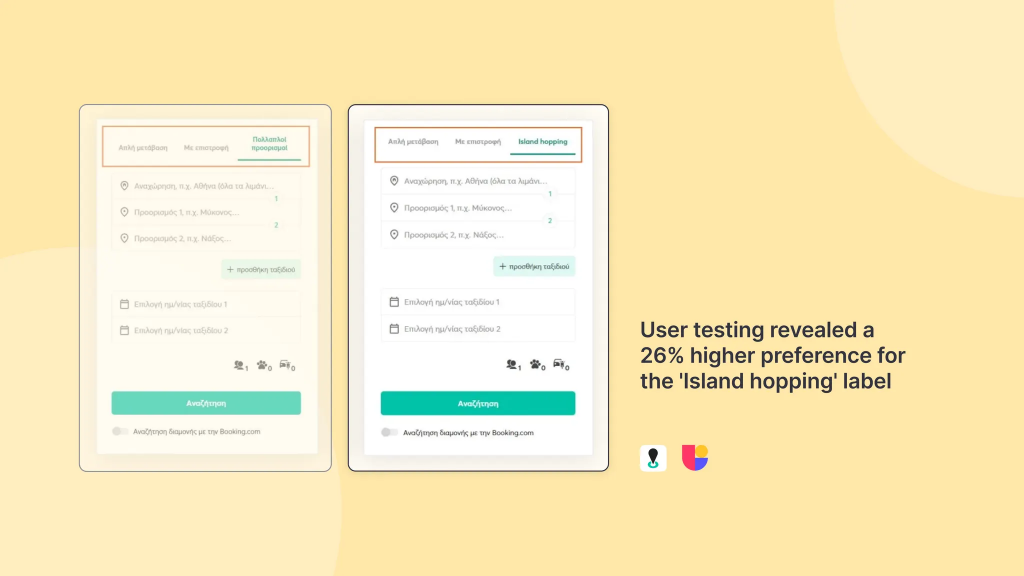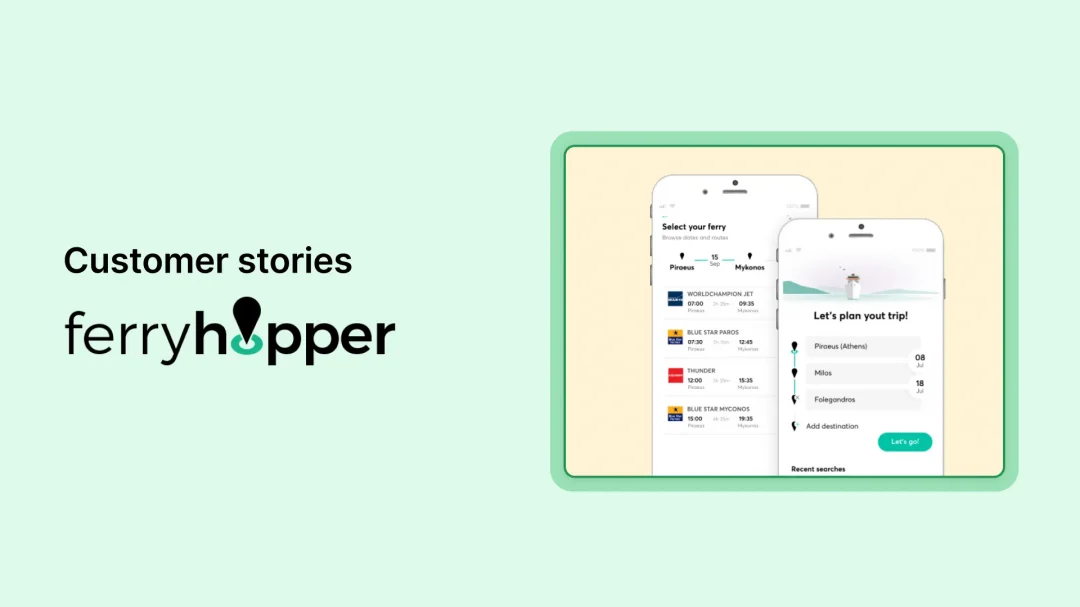About Ferryhopper
Ferryhopper is revolutionizing online ferry booking, aiming to change the way people travel by ferry. Collaborating with more than 190 ferry companies across 33 countries, they bring a fresh and seamless ferry booking experience.
Ferryhopper is always exploring and implementing new ways to make ferry travel hassle-free. After all, this is also where the team books its own ferry tickets. Why make it hard to book your ferry when it can be an enjoyable part of your trip?

The Task
Ferryhopper’s mission is to make ferry travel simple and intuitive for travelers coming from all over the globe. Clear, localized microcopy in the 15 languages supported by the platform is essential; whether it’s a call-to-action, a tab label, or a placeholder, every word shapes the user experience.
Crafting the right wording isn’t straightforward. They needed a fast, scalable, and reliable method to test microcopy across multiple languages, ensuring that updates on their website and app truly meet their users’ needs.
“Rapid experimentation can lead to quicker and smarter decisions. And this is where we usually use Useberry. For experiments with low setup effort, straightforward questions, and the need for quick results.”
– Panagiotis Sarafis, CPO at Ferryhopper
By running around 20 copy tests on Useberry in different languages, Ferryhopper was able to refine and establish an optimized approach for conducting unmoderated microcopy preference tests.
The Challenge
The Ferryhopper team had to overcome a few practical hurdles common in multilingual UX work. Scaling microcopy testing across multiple markets introduced both linguistic and operational challenges the team needed to address:
- High linguistic diversity: With 15 supported languages, microcopy had to be clear, concise, and contextually accurate across cultures.
- Quick setup: The team wanted to minimize the effort needed to run the tests.
- Fast decision-making: Insights were needed within days, not weeks, to keep pace with product updates.
- Finding the right audience: Recruiting users for specific languages and demographics was time-consuming without a built-in solution.
Testing Approach
Ferryhopper approached testing with a clear, repeatable framework that any product team could apply to their own UX copy experiments. Each test included:
- Single-task flows → to observe comprehension in real booking scenarios and relevant pages
- Preference tests → to compare different microcopy versions
- Follow-up questions → to understand user reasoning behind choices
Microcopy Testing Tips by Ferryhopper:
Set context first
The team starts with a simple warm-up task so participants can explore the page before evaluating the copy. This ensures they understand the flow and purpose without feeling biased by first impressions.
Structured preference testing
Clear action titles and precise instructions are used to focus feedback on clarity and helpfulness.
Utilize visuals for recall
Including screenshots in follow-up questions helps participants remember where the copy appeared and give more specific feedback.
Target the right audience
Native speakers familiar with travel platforms are recruited to ensure linguistic accuracy and contextual relevance.
Sample size for quantitative insights
For each language version, the team tests with a sample of 20–30 participants, enabling them to capture clear quantitative preferences while still collecting qualitative feedback to understand the reasoning behind choices.

The Solution
By leveraging Useberry’s integrated Participant Pool and multilingual targeting filters, Ferryhopper was able to:
- Test multiple languages in parallel → reducing turnaround time from weeks to just 1–2 days per test.
- Combine quantitative and qualitative insights → preference metrics plus open-text answers gave both clarity and context.
- Roll out winning copy variants → with confidence that they worked across languages.
“Useberry made multilingual testing effortless. It turned complex, weeks-long processes into fast, repeatable experiments with real user insight.”
– Fani Avdela, UX Researcher at Ferryhopper
For example, testing the Travel mode tabs revealed subtle differences in how travelers interpreted wording across English, French, and Greek versions. More specifically, in the Greek language, when testing the Travel Mode Tabs texts, they discovered an increased user preference for the new version (the one mentioning “island-hopping”) by 26%, whereas English-speaking users favored the “Multi-destination” version by 55%.

Takeaways
Speed & scale: The team iterated across multiple projects in just a few weeks, a pace that wasn’t possible with manual recruiting. Results started coming in within 1–2 days.
Localized confidence: Testing in native languages gave cultural nuance they wouldn’t have spotted otherwise.
Quant + qual wins: Preference metrics revealed what worked; user comments told them why.
Impact on UX: Small copy changes drove measurable improvements in clarity, speed, and preference across journeys.
For Ferryhopper, Useberry became the go-to tool for preference testing that helps keep their excellent product messaging on point across multiple languages, supported by our global Participant Pool, which made recruitment quick and easy. If your study goal is similar, you can start with the Text-based Preference Testing Template to simplify setup and keep your study focused.
Ready to scale your research with us like Ferryhopper?
Get started with Useberry.




